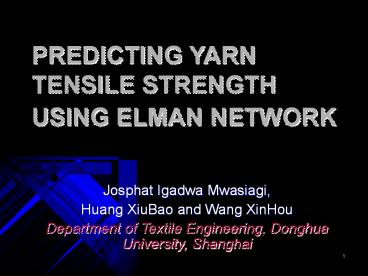PREDICTING YARN TENSILE STRENGTH USING ELMAN NETWORK - PowerPoint PPT Presentation
Title:
PREDICTING YARN TENSILE STRENGTH USING ELMAN NETWORK
Description:
The reported models have different models for rotor and ringframe yarns ... squared error between the networks and the targeted outputs, was used as the ... – PowerPoint PPT presentation
Number of Views:65
Avg rating:3.0/5.0
Title: PREDICTING YARN TENSILE STRENGTH USING ELMAN NETWORK
1
PREDICTING YARN TENSILE STRENGTH USING ELMAN
NETWORK
- Josphat Igadwa Mwasiagi,
- Huang XiuBao and Wang XinHou
- Department of Textile Engineering, Donghua
University, Shanghai
2
Introduction
- The influence of fiber properties to the yarn
strength characteristics has been a subject of
study by many researchers, Jackowski et al,
2002 Ureyen et al, 2006, Ghosh et al, 2005(a)
Ghosh et al, 2005(b) - The reported artificial Neural Networks (NN)
models use HVI characteristics together with yarn
fineness and TPI as inputs - The reported models have different models for
rotor and ringframe yarns - This paper discusses the design of a single NN
model to predict the tensile strength of rotor
and ring spun yarns
3
Elman Network
- -The Elman network is a type of a recurrent feed
forward neural network, with a feedback
connection from the output of the hidden layer
neurons to the input of the network, - -The Elman network has tansig neurons in its
hidden (recurrent) layer, and purelin neurons in
its output layer
4
The architecture of Elman Network
5
Training Algorithm
- Training involves adjusting the weights and
biases of the network so as to minimize the
networks performance function - This can be done using a by using a technique
called backpropagation (BP), which involves
performing computations backwards through the
network Ham et al, 2003
6
Fletcher-Reeves Update method
- - Fletcher-Reeves Update is a modification of the
BP technique - -it is much faster than the original BP technique
7
Materials
- Cotton lint and yarn samples were collected from
four textile factories in Kenya. For every yarn
sample collected, a sample of the corresponding
cotton lint mixture used to spin the yarn was
also collected - The details of the cotton and yarn samples
collected are given in table 1. A total of 410
samples were collected. - The quality characteristics of the cotton lint
and yarn samples were measured under standards
laboratory conditions in Shanghai-China
8
Table 1 Cotton Lint and Yarn samples
Cotton Mill Machine Yarn Spinning Lint Code Type Ne Speed (rpm)
Meru AR D Rotor 27 68,0000 Meru AR D Rotor 12.5 68,0000 Meru AR D Rotor 7.5 57,0000 Voi AR B Ringframe 30 11,0000 Voi AR B Ringframe 20 10, 000 WT AR A Ringframe 30 12,000 Kitui AR A Ringframe 30 12,0000 Kitui AR A Ringframe 24 11,0000 Kitui AR C Ringframe 24 8,000
9
Methods
- A strength prediction algorithm was design
as shown below.
10
Methods
- The NN model used Elman network with
Fletcher-Reeves Update as the BP network training
algorithm and gradient descent with momentum as
the weight/bias learning function was designed. - Several options for the number of neurons in the
hidden layer were tried, in order to arrive at an
optimum design - During training, mean square error (mse), which
is the average squared error between the networks
and the targeted outputs, was used as the
performance function - To investigate the performance of the network in
more details, a regression analysis between the
networks response and the corresponding targets
was performed.
11
Results and Discussions
12
Results and Discussions
13
Results and Discussions
- From figures 2 and 3 the network stabilizes at 6
neurons. Increase of the number of neurons above
6 does not cause any significant change in the
performance or prediction ability of the network.
14
Results and Discussions
- The performance of the trained network for the
training, validation and test subsets are given
in figure 4. Figure 5 shows the linear regression
between the network outputs and the corresponding
targets.
15
Results and Discussions
16
Results and Discussions
- The final mse value for the test data was 0.0156.
- The network outputs tracks targets reasonable
well, with a correlation coefficient (R-value) of
0.974.
17
Conclusions
- An Elman Network model was trained using
Fletcher-Reeves Update conjugate gradient
training algorithm. - The network predicted the tensile strength of
cotton yarn samples consisting of ring and rotor
spun yarns, giving an mse value of 0.0156. The
correlation coefficient (R-Value) between
predicted and targeted values for the network was
0.974.
18
Q and A
- Thank You for Your Kind Attention































